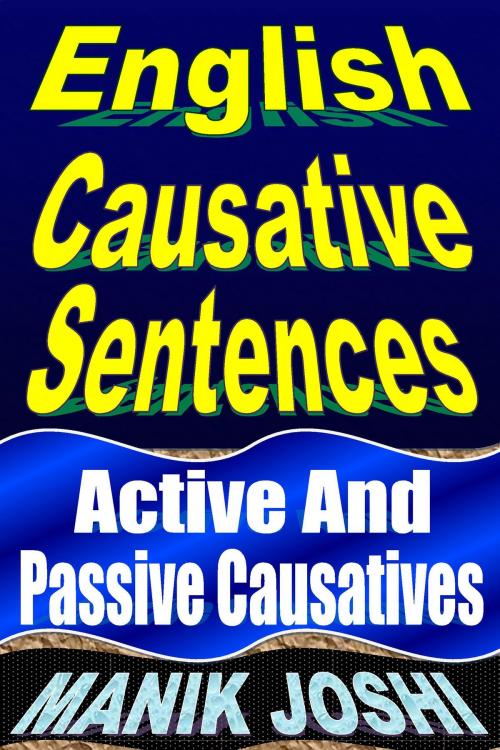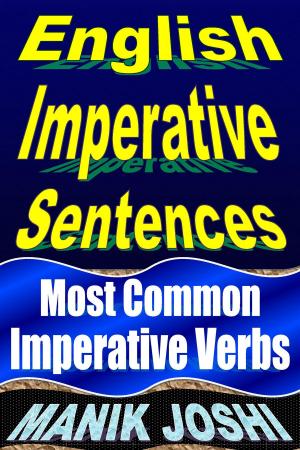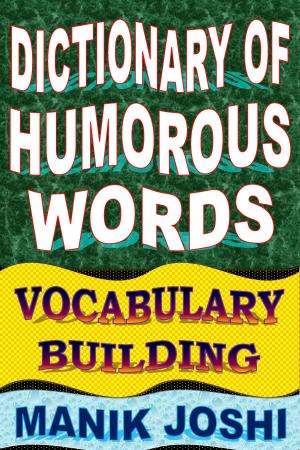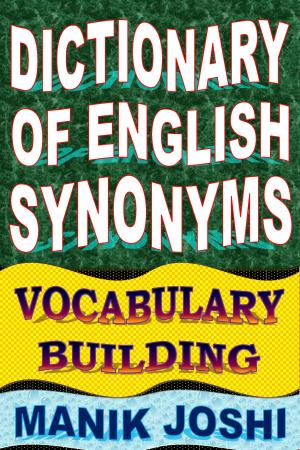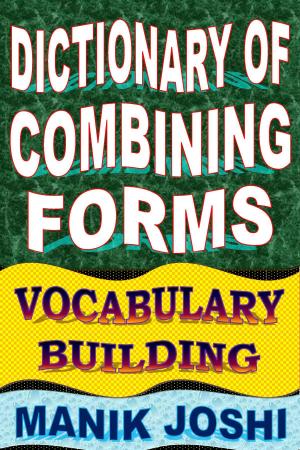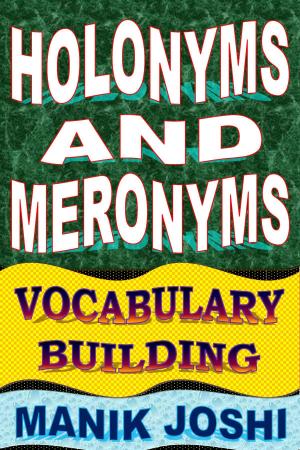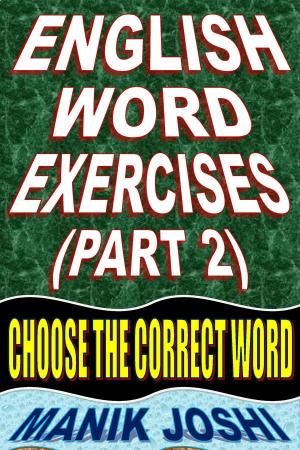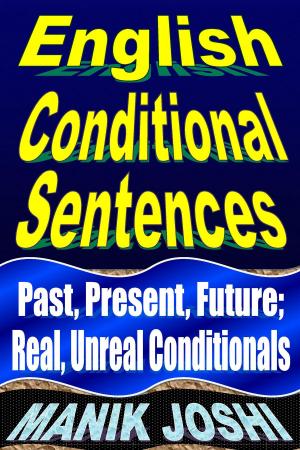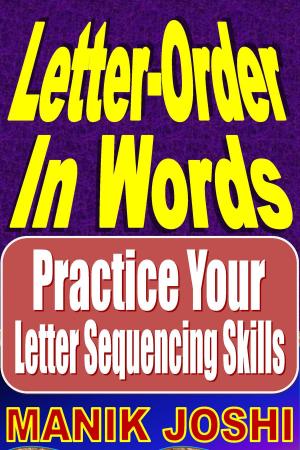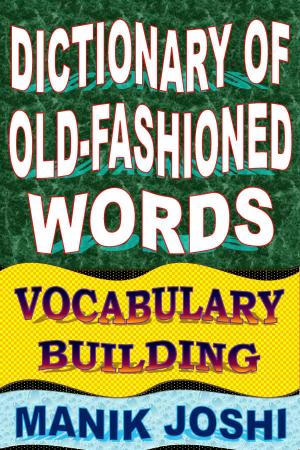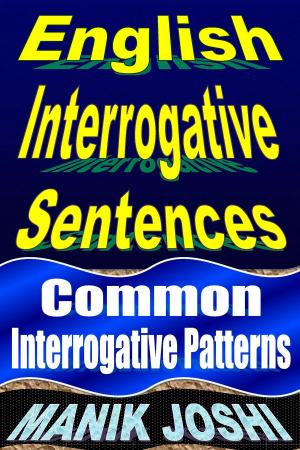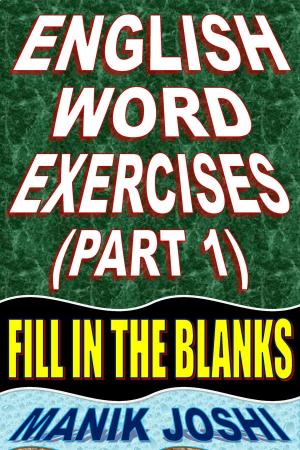English Causative Sentences: Active and Passive Causatives
Nonfiction, Reference & Language, Study Aids, ESL, Health & Well Being, Self Help, Self Improvement, Self-Esteem, Foreign Languages| Author: | Manik Joshi | ISBN: | 9781301810598 |
| Publisher: | Manik Joshi | Publication: | February 8, 2013 |
| Imprint: | Smashwords Edition | Language: | English |
| Author: | Manik Joshi |
| ISBN: | 9781301810598 |
| Publisher: | Manik Joshi |
| Publication: | February 8, 2013 |
| Imprint: | Smashwords Edition |
| Language: | English |
This Book Covers The Following Topics:
What are “Causative Sentences”?
Causative Sentences -- HAVE
Structure 1(A) ---- Active Causative Structure
Structure 1(B) ---- Passive Causative Structure
Structure 2(A) ---- Active Causative Structure
Structure 2(B) ---- Passive Causative Structure
Structure 3(A) ---- Active Causative Structure
Structure 3(B) ---- Passive Causative Structure
Causative Verb ‘Have’ and Tense Change
Causative Sentences -- GET
Structure (1) ---- Active Causative Structure
Structure (2) ---- Passive Causative Structure
Causative Verb ‘Get’ and Tense Change
Causative Sentences -- MAKE
Causative Sentences -- LET
Causative Sentences -- HELP
Sentences with Verb ‘Cause’
Other ‘Causative Verbs’
Use of ‘Modal Verbs’ with Causative Verbs
Exercises: 1(A) and 1(B)
Exercises: 2(A) and 2(B)
Exercises: 3(A) and 3(B)
Exercises: 4(A) and 4(B)
Sample This:
What are “Causative Sentences”?
In a causative, a person or thing does not perform an action directly. The subject (person or thing) causes it to happen by forcing, persuading, assisting, etc. an agent (another person or thing) to perform it. The subject (person or thing) does not carry out an action oneself but rather has the action done by an agent (another person or thing).
Examples:
Faulty design caused a bridge to collapse.
Modern lifestyles cause children and adults to spend most of their time indoors.
Rain caused water to collect on the road.
She caused needle to run.
Causative verbs – Have, Get, Make, Let, Help -- Comparison
Causative ‘Have’ has less force and authority than Causative ‘Get’.
Causative ‘Get’ has less force and authority than Causative ‘Make’
Causative Verb ‘Have’ -- used to express “arrangement/duty/responsibility” [Less Forceful]
Causative Verb ‘Get’ -- used to express “encouragement/persuasion". [Forceful]
Causative Verb ‘Make’ -- used to express "compulsion/insistence/requirement” [Most Forceful]
Causative Verb ‘Let’ -- used to express “permission". [No Force]
Causative Verb ‘Help’ -- used to express “assistance". [No Force]
Causative ‘Have’ is more formal than causative ‘Get’.
In the imperative form, causative ‘Get’ is more frequent than causative ‘Have’.
Types of Causative Verbs
Causative structures are of two types –
(1). ‘Active’ in Nature – (Done By Somebody/Something)
(2). ‘Passive’ in Nature – (Done To Somebody/Something)
Passive causatives are used to take attention away from the doer of the action, and give more attention to the action being done.
ALSO NOTE:
“Have somebody do something” is more common in American English.
“Get somebody to do something” is more common in British English.
All causative verbs are transitive.
CAUSATIVE VERB – HAVE
Structure 1(A) ---- Active Causative Structure
Subject + Have (Causative Verb) + Agent (Someone/Something) + Base Form of Verb + Object (Someone/Something)
Example: I have him take my photograph. (Present)
Explanation:
I arrange for my photograph to be taken by him.
[I cause him to take my photograph.]
Therefore, this is like active causative structure.
Example: I had him take my photograph. (Past)
Explanation:
I arranged for my photograph to be taken by him.
[I caused him to take my photograph.]
Therefore, this is like active causative structure.
Example: I will have him take my photograph. (Future)
Explanation:
I will arrange for my photograph to be taken by him.
[I will cause him to take my photograph.]
Therefore, this is like active causative structure.
OTHER EXAMPLES:
CAUSATIVE - HAVE --
Have/Has + Someone/Something + Base Form of Verb
Note: This pattern may denote past, present, or future tense based on another verb in the sentence.
Her desire to have me write a memoir only raised my stress level.
We are so blessed to have her sing on one of our songs.
It is one thing to have somebody else ask him about what he has done and it is quite another to have me ask him.
He refused to have investigation officers search his home.
This Book Covers The Following Topics:
What are “Causative Sentences”?
Causative Sentences -- HAVE
Structure 1(A) ---- Active Causative Structure
Structure 1(B) ---- Passive Causative Structure
Structure 2(A) ---- Active Causative Structure
Structure 2(B) ---- Passive Causative Structure
Structure 3(A) ---- Active Causative Structure
Structure 3(B) ---- Passive Causative Structure
Causative Verb ‘Have’ and Tense Change
Causative Sentences -- GET
Structure (1) ---- Active Causative Structure
Structure (2) ---- Passive Causative Structure
Causative Verb ‘Get’ and Tense Change
Causative Sentences -- MAKE
Causative Sentences -- LET
Causative Sentences -- HELP
Sentences with Verb ‘Cause’
Other ‘Causative Verbs’
Use of ‘Modal Verbs’ with Causative Verbs
Exercises: 1(A) and 1(B)
Exercises: 2(A) and 2(B)
Exercises: 3(A) and 3(B)
Exercises: 4(A) and 4(B)
Sample This:
What are “Causative Sentences”?
In a causative, a person or thing does not perform an action directly. The subject (person or thing) causes it to happen by forcing, persuading, assisting, etc. an agent (another person or thing) to perform it. The subject (person or thing) does not carry out an action oneself but rather has the action done by an agent (another person or thing).
Examples:
Faulty design caused a bridge to collapse.
Modern lifestyles cause children and adults to spend most of their time indoors.
Rain caused water to collect on the road.
She caused needle to run.
Causative verbs – Have, Get, Make, Let, Help -- Comparison
Causative ‘Have’ has less force and authority than Causative ‘Get’.
Causative ‘Get’ has less force and authority than Causative ‘Make’
Causative Verb ‘Have’ -- used to express “arrangement/duty/responsibility” [Less Forceful]
Causative Verb ‘Get’ -- used to express “encouragement/persuasion". [Forceful]
Causative Verb ‘Make’ -- used to express "compulsion/insistence/requirement” [Most Forceful]
Causative Verb ‘Let’ -- used to express “permission". [No Force]
Causative Verb ‘Help’ -- used to express “assistance". [No Force]
Causative ‘Have’ is more formal than causative ‘Get’.
In the imperative form, causative ‘Get’ is more frequent than causative ‘Have’.
Types of Causative Verbs
Causative structures are of two types –
(1). ‘Active’ in Nature – (Done By Somebody/Something)
(2). ‘Passive’ in Nature – (Done To Somebody/Something)
Passive causatives are used to take attention away from the doer of the action, and give more attention to the action being done.
ALSO NOTE:
“Have somebody do something” is more common in American English.
“Get somebody to do something” is more common in British English.
All causative verbs are transitive.
CAUSATIVE VERB – HAVE
Structure 1(A) ---- Active Causative Structure
Subject + Have (Causative Verb) + Agent (Someone/Something) + Base Form of Verb + Object (Someone/Something)
Example: I have him take my photograph. (Present)
Explanation:
I arrange for my photograph to be taken by him.
[I cause him to take my photograph.]
Therefore, this is like active causative structure.
Example: I had him take my photograph. (Past)
Explanation:
I arranged for my photograph to be taken by him.
[I caused him to take my photograph.]
Therefore, this is like active causative structure.
Example: I will have him take my photograph. (Future)
Explanation:
I will arrange for my photograph to be taken by him.
[I will cause him to take my photograph.]
Therefore, this is like active causative structure.
OTHER EXAMPLES:
CAUSATIVE - HAVE --
Have/Has + Someone/Something + Base Form of Verb
Note: This pattern may denote past, present, or future tense based on another verb in the sentence.
Her desire to have me write a memoir only raised my stress level.
We are so blessed to have her sing on one of our songs.
It is one thing to have somebody else ask him about what he has done and it is quite another to have me ask him.
He refused to have investigation officers search his home.
